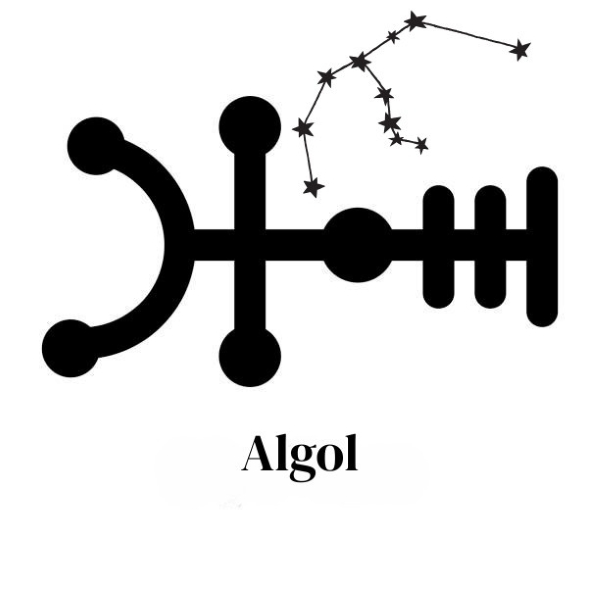Algol Facts and History
Algol Facts and History
Algol , also known as the “Demon Star”, is located in the constellation Perseus. It is a multiple star system, of which the most famous components are Algol A, Algol B and Algol C. The most significant and impressive feature of this system is that it is a so-called. the ecliptic binary system. This means that the two stars orbit each other, and from our perspective, an eclipse of one of them occasionally occurs. This is precisely why Algol changes its brightness at regular intervals.
Its variability was observed even in ancient times. The ancient Egyptians recorded the light cycles of Algol, and the first modern scientist to document the change in brightness was the Italian astronomer Geminiano Montanari in the 17th century. Later, John Goodricke, an English astronomer, gave the first correct explanation of this phenomenon in the 18th century, assuming that it was a binary system in which one star eclipsed the other.
Algol is located at a distance of about 90 light years from Earth and is one of the most famous celestial bodies in the context of variable stars. Its symbolic meaning and name have roots in the Arabic language, where “al-Ghūl” means “demon” or “spirit”. This etymology and the ancient experience of the unusual change of its light made Algol occupy a special place in myth and astrological tradition.
Algol – Medusa’s head
In mythology, Algol is identified with the head of Medusa, the Gorgon whose gaze turned anyone who looked at her to stone. Perseus, with the help of divine gifts, managed to overcome her, cut off her head and use it later as a weapon. That severed head of Medusa, held up in Perseus’s hand, becomes an image conveyed by the sky – Algol as a star in the constellation of Perseus.
Jungianly speaking, Medusa is a figure of the Shadow, especially in its most terrifying and paralyzing form. Her power is not in the body, but in the look: in the encounter with what man cannot bear from his own unconscious depth. Medusa’s gaze is a mirror that brings back the confrontation with one’s own inner darkness, and the feeling of numbness before it symbolizes the powerlessness of the ego to fight the power of the unconscious.
Perseus does not defeat Medusa with a direct look, but with the help of a mirror – a shield given to him by Athena. This indicates an important psychological fact: we do not face the Shadow head-on, but through the mediation of consciousness, through symbolic understanding and transformation. Only through reflection and distance is it possible to look at what is too terrifying.
Medusa’s head , when cut off, does not lose its power. On the contrary, Perseus uses it as a weapon that paralyzes enemies. In this sense, Algol also symbolizes the two-way energy of the Shadow: what is most terrible in us can, if integrated, become a source of protection and strength.
In the sky, Algol pulsates between light and darkness, just as Medusa’s power oscillates between terror and transformative potential. It is not only a “demon” star, but also a reminder that man must face his own inner monsters. If avoided, they paralyze. If recognized, they can become a source of strength and protection in the process of individuation.
PERSEUS AND THE CUT OFF OF THE HEAD OF MEDUSA – A PSYCHOLOGICAL TRANSITION
In the myth, Perseus enters the cave of the Gorgon to confront Medusa. His task is almost impossible: no one can look at Medusa without being petrified. However, Perseus uses the gifts of the gods – a shield-mirror from Athena, winged sandals from Hermes and a sword from Hephaestus. These weapons and help from a higher level indicate that the ego cannot fight the forces of the unconscious alone; the support of the higher functions of the psyche is needed – intuition, wisdom and spiritual strength.
When Perseus cuts off Medusa’s head, he does not completely destroy her. Her gaze remains alive and powerful, even in death. It symbolizes that the Shadow cannot be destroyed or removed. She can be decapitated – releasing her paralyzing influence – but her energy remains, now under the hero’s control. The severed head becomes a powerful weapon in his hands, a means of protection and power.
Psychologically speaking, this act marks the transition from powerlessness to active coping. The ego, through courage and the mediation of consciousness, takes control of the destructive content of the unconscious. It is a process of transformation: what was previously deadly and terrifying now becomes a source of inner strength.
The myth also shows that facing the Shadow always requires a symbolic “distance”. Perseus never looks directly at Medusa – he watches her through a reflection. This means that unconscious contents must be processed, translated into symbols, dreams, images, myths, so that they can be integrated without destroying consciousness. Jung would say that this is where the essence of active imagination is hidden: dialogue with the Shadow does not destroy consciousness, but expands it.
When Perseus lifts Medusa’s head, he shows the world that he has conquered what everyone fears. In the sky, that image remains forever imprinted in the constellation Perseus – and in the star Algol, in the very head of Medusa, the memory of that moment remains. It is an eternal archetypal scene: the hero who has faced the darkness and won power over it, but not to destroy it, but to harness it in the service of the development of consciousness.
ASTROLOGICAL USES OF ALGOL
In astrology, Algol has a long and complex history of interpretation. Back in Hellenistic astrology and among medieval Arab astrologers, it was considered one of the most powerful fixed stars, often associated with dangers, sudden losses and crises, but also with powerful eruptive energies that can bring about transformation.
Traditionally, Algol was associated with the image of Medusa’s head and was perceived as a symbol of destructive forces, violence and disruption. However, in modern astrology the interpretations have been expanded: Algol is also seen as a bearer of enormous vital force, an energy that can be destructive if suppressed or unconsciously used, but also liberating and creative if integrated.
In the astrological ephemeris Algol is counted today as a fixed star at 26° Taurus. If it is in conjunction with personal planets or axes in the birth chart (Ascendant, MC, Descendant, IC), it is considered to have a strong influence on the individual’s life, bringing themes of intense trials, inner struggles and the possibility of deep transformation.

